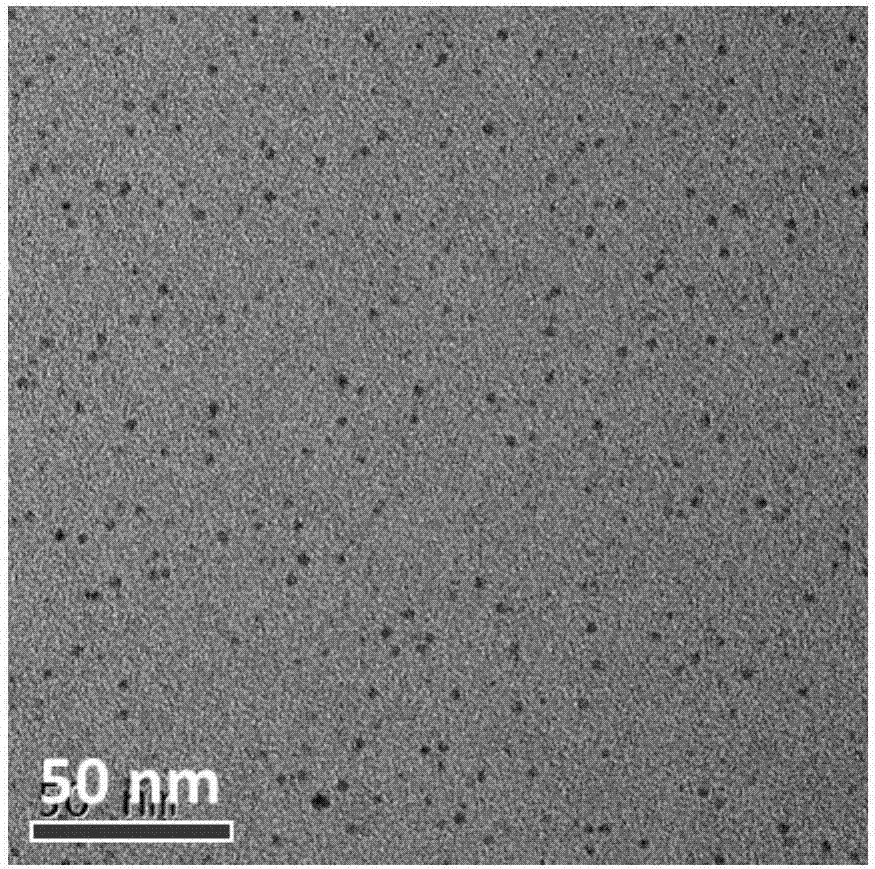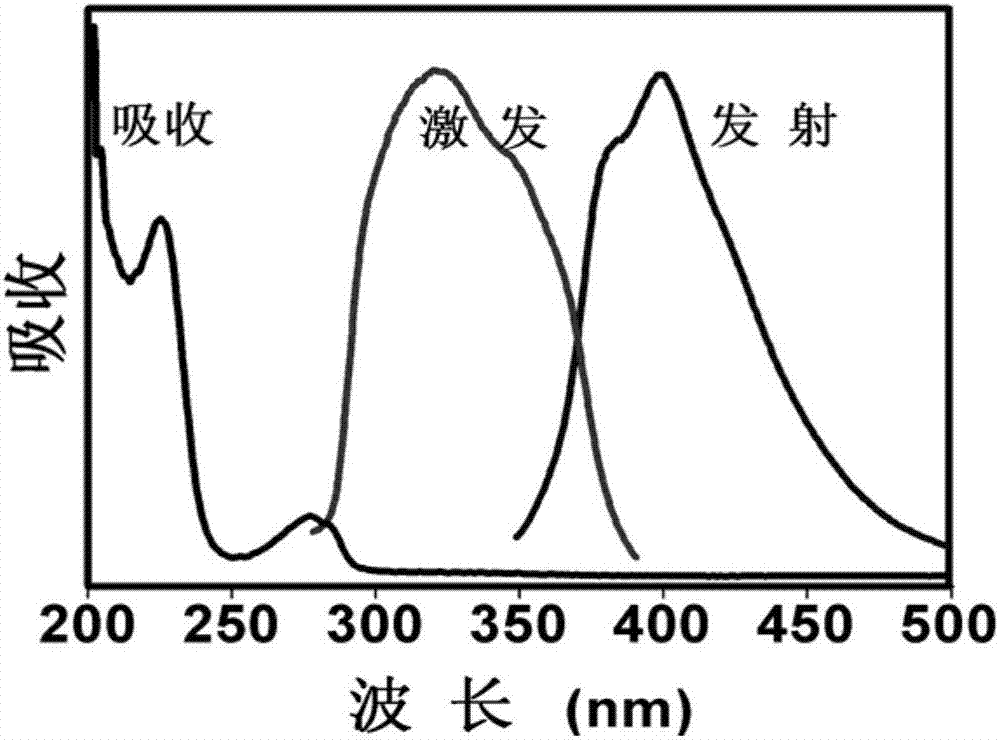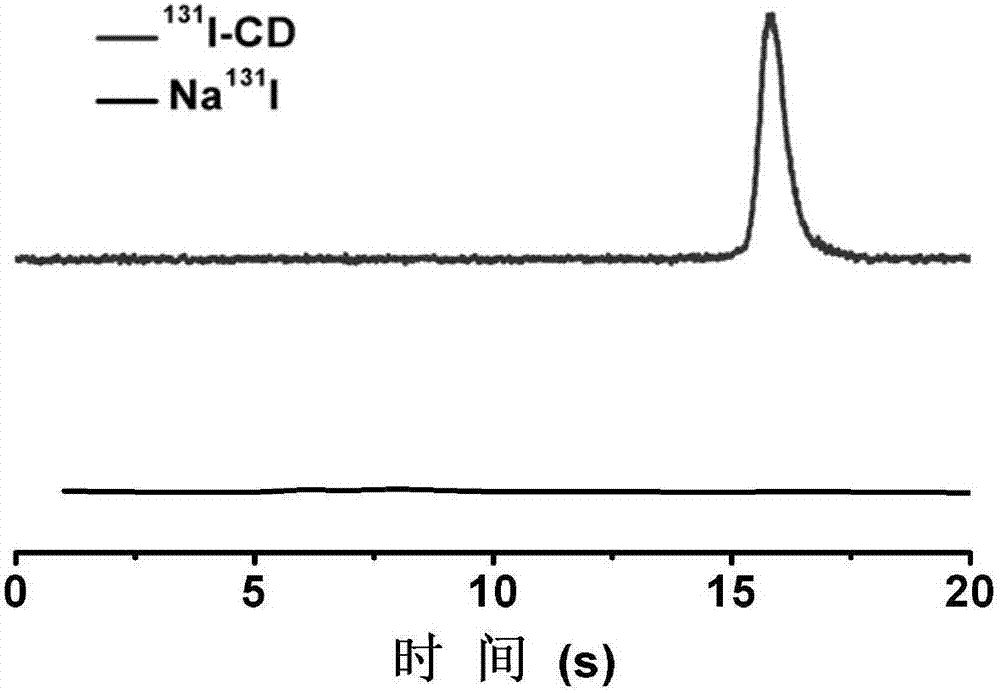Fluorescent carbon dot for labeling of radionuclide iodine, synthetic method and application
A technology of radionuclide and fluorescent carbon dots, which is applied in the fields of nanomedicine, molecular imaging, and nuclear medicine, can solve problems such as complicated operation and difficult purification, and achieve high fluorescence yield, good physical stability and radiochemical stability, The effect of strong radiochemical stability
- Summary
- Abstract
- Description
- Claims
- Application Information
AI Technical Summary
Problems solved by technology
Method used
Image
Examples
Embodiment 1
[0025] Dissolve 0.5g of citric acid and 0.1g of tyrosine in water, adjust the pH to 1, make the solution clear, stir evenly, put it in a high-pressure reactor, and react at 180°C for 6 hours. After cooling, put The resulting carbon dot solution was purified by dialysis for 24 h with a molecular weight 500 dialysis bag.
[0026] Dissolve 10 mg of carbon dots in DMF, add 20 mg of EDC and 20 mg of NHS for activation for two hours, then add 100 mg of methoxy PEG2000 amino, react overnight, and dialyze with a dialysis bag with a molecular weight of 2000 for one day.
[0027] Take 10 μg of PEG-modified carbon dots (dissolved in 100 μl of water) into the EP tube coated with 100 μg of chloroglycoside, and then add 1 mCi of Na 125 I solution, shaking and reacting for half an hour, take out the solution to obtain the nuclide 125 I labeled carbon dots.
[0028] The TEM image of fluorescent carbon dots, the fluorescence spectrum image of fluorescent carbon dots, the HPLC image of carbon...
Embodiment 2
[0030] Dissolve 0.6g citric acid and 0.3g tyrosine in water, adjust pH=1.5, make the solution clear, stir evenly, place in a high-pressure reactor, react at 160°C for 12h, after cooling, put The obtained carbon dot solution was purified by silica gel column.
[0031] Dissolve 15 mg of carbon dots in DMF, add 30 mg of EDC and 30 mg of NHS for activation for two hours, then add 150 mg of folic acid-PEG2000-amino, react overnight in the dark, and then dialyze with a dialysis bag with a molecular weight of 2000 for two days.
[0032] Take 20 μg of folic acid-modified carbon dots (dissolved in 100 μl of water) and add to an EP tube containing 200 μg of chloramine T, and then add 1 mCi of Na 131 I solution, shaking and reacting for 10 minutes, take out the solution to obtain the nuclide 131 I labeled carbon dots.
Embodiment 3
[0034] Dissolve 0.4g citric acid and 0.4g tyrosine in water, adjust the pH=1.5, make the solution clear, stir evenly, put it in a high-pressure reactor, and react at 200°C for 4 hours. After cooling, put The resulting carbon dot solution was purified by dialysis for 24 h with a molecular weight 500 dialysis bag.
[0035] Dissolve 12 mg of carbon dots in DMF, add 25 mg of EDC and 25 mg of NHS for activation for two hours, then add 10 mg of c(RGDfk) polypeptide, react overnight in the dark, and dialyze with a dialysis bag with a molecular weight of 1000 for two days.
[0036] Take 15 μg of RGD-modified carbon dots (dissolved in 120 μl of water) and add them to the EP tube coated with 150 μg of chloroglycoside, and then add 1 mCi of Na 124 I solution, shaking and reacting for 1 hour, take out the solution to obtain the nuclide 124 I labeled carbon dots.
PUM
 Login to View More
Login to View More Abstract
Description
Claims
Application Information
 Login to View More
Login to View More - R&D
- Intellectual Property
- Life Sciences
- Materials
- Tech Scout
- Unparalleled Data Quality
- Higher Quality Content
- 60% Fewer Hallucinations
Browse by: Latest US Patents, China's latest patents, Technical Efficacy Thesaurus, Application Domain, Technology Topic, Popular Technical Reports.
© 2025 PatSnap. All rights reserved.Legal|Privacy policy|Modern Slavery Act Transparency Statement|Sitemap|About US| Contact US: help@patsnap.com



